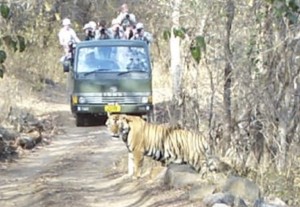
Last summer a big game hunter from Minnesota shot Cecil, a famous male lion, in Zimbabwe. The Zimbabwean officials didn’t press charges against Cecil’s killer.
Many people in this country were outraged that such a rare and beautiful beast had been murdered. The response in Africa was different, however. For us a lion—especially a noble and handsome male—symbolizes freedom and wildness. In Africa, however, a lion means danger.
We live in a protected bubble from which most predators have been excluded. It is true that occasionally a mountain lion will injure or kill a human, but fortunately that is a very rare, newsworthy incident. Black bears are also responsible for a few injuries and rare deaths here in Colorado. The real killer is not a predator but the sweet, innocent herbivore—deer.
Biologist E. O. Wilson has recently written a book advocating that half of the planet become a nature reserve. He wrote: “…I propose that only by committing half of the planet’s surface to nature can we hope to save the immensity of life-forms that compose it.â€
I grieve for the loss of biological diversity (biodiversity). Although we cannot know exactly, it is estimated that species of plants and animals are going extinct at 1000 times the normal rate; we are in the 6th mass extinction. There have been five prior mass extinctions, the last one being about 65 million years ago when a huge meteor hit off the coast of Mexico. The resulting explosion changed the climate for centuries, killing off dinosaurs. What is different about the current mass extinction is that it is caused by a single species—ours.
Each species has evolved strategies to maximize reproduction, to gather nutrients efficiently and to ward off other species that imperil it. We are no different, except we have been so amazingly successful. Sadly, our success endangers nonhuman species—and probably ourselves, since our livelihood depends on the web of life.
I have a problem with those who are “prolifeâ€. Our human success is causing the extinction of other animals and plants. By preventing women from access to family planning and safe abortion services, the people who claim to be “prolife†are actually destroying the biodiversity that makes our planet habitable.
Although I haven’t read Wilson’s “Half-Earth: Our Planet’s Fight for Lifeâ€, its premise troubles me. Yes, it is important to do what we can to protect other species. Yes, the major cause of loss of species is loss of habitat. Yes, preserves (both terrestrial and marine) have shown their value in preserving biodiversity. The Center for Biological Diversity has a brilliant record of protecting endangered species by preserving habitat.
Turning half the Earth into preserves would slow the loss of biodiversity. But what about the people who currently live on that land—many of whom live in overcrowded, developing countries? what would happen to them?
We had the good fortune to visit the Ranthambhore preserve in India where we observed a Bengal tiger in the wild. We also heard about people who were forced off that land and repatriated to a nearby village. They now make their living by making and selling souvenirs to tourists. This model would not work for half of Earth’s surface, however. Where could all those people settle?
This conundrum is one of the plotlines of “The Hungry Tide†by Amitav Ghosh. This wonderful novel takes place in the Sundarbans, the deltas of four major rivers where they empty into the Bay of Bengal. Thousands of squatters settled on Marichjhanpi Island, an Indian animal refuge, in1979. Piya, a protagonist, biologist and protector of animals, is distressed when settlers kill a man-eating tiger. Forest Guards moved in and destroyed the settlement—and the settlers. Thousands of people were killed in this genocide. Although this sounds incredible, it is based on history.
Thanks to the foresight of Americans a century ago, we have the National Park Service, one of the agencies that take care of our public lands. We should be proud that 14% of our land is currently protected. Costa Rica may have the highest percentage of land preserved for nonhuman use at 25%. It is important to preserve what we have and to continue to protect more wilderness, parks, forests and roadless areas for our enjoyment, and especially for the benefit of other species. However, it is important to keep human rights in mind when considering making new protected areas. Voluntary family planning will help achieve that goal by decreasing population pressure.
© Richard Grossman MD, 2016